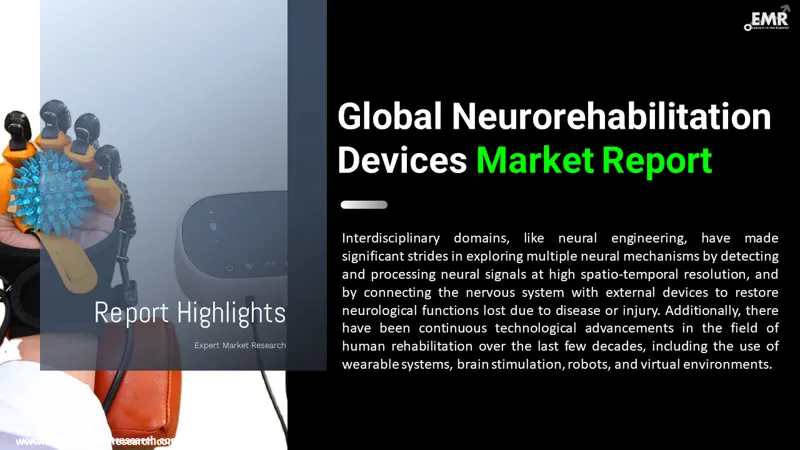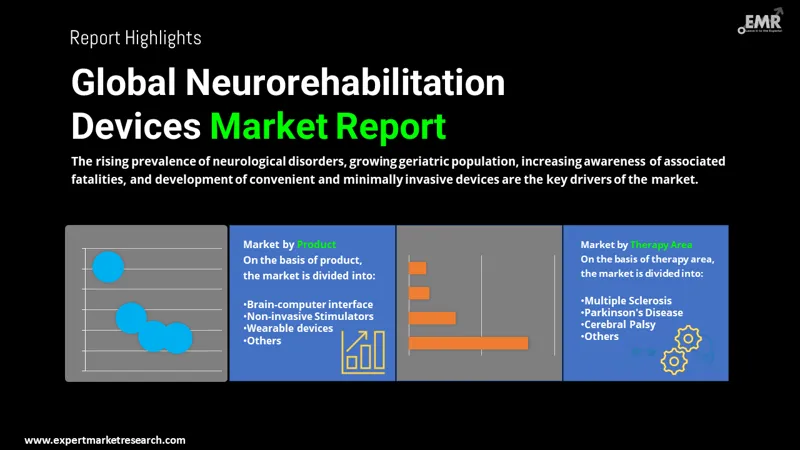
Consumer Insights
Uncover trends and behaviors shaping consumer choices today
Procurement Insights
Optimize your sourcing strategy with key market data
Industry Stats
Stay ahead with the latest trends and market analysis.
The neurorehabilitation devices market was valued at USD 948.76 Million in 2025 and is expected to grow at a CAGR of 7.90%, reaching USD 2029.41 Million by 2035. The market growth is supported by increasing incidence of neurological injuries and adoption of advanced rehabilitation technologies.
Base Year
Historical Period
Forecast Period
Compound Annual Growth Rate
7.9%
Value in USD Million
2026-2035
*this image is indicative*
Multiple alternatives for intervention in neurological rehabilitation include occupational therapy, electric physiotherapy, physical therapy, speech and language therapy, and other methods; new treatment methods produced enabled by modern scientific and technological progress also play an important role and are expected to boost market growth. For example, advanced brain-computer interface research has attained interactive computer game operations with fine brainwave control. Further, the ageing global population is expected to drive market growth. North America, Asia and Europe are likely to be key markets.

Read more about this report - REQUEST FREE SAMPLE COPY IN PDF
Neurological diseases leading to motor/cognitive impairments are major causes of adult-onset disability. While the number of people affected is over a billion, the number is likely to rise due to the quickly ageing global population. It is estimated that neurological disorders and injuries explain over six percent of the global burden of disease. With over six percent of DALY (disability-adjusted life years) across the globe, neurological disorders indicate a key widespread clinical condition. Among neurological disorders, a significant burden in DALYs is explained by cerebral-vascular disease (over fifty percent), such as stroke. Stroke and spinal cord injury (SCI), account for over fifty percent of the adult-onset disability and, more than a billion people experience some form of disability. The common lack of full recovery necessitates the development of novel neurorehabilitative treatments suited to patients and better targeting the particular disability. Such need of neurorehabilitative treatments is likely to drive the global neurorehabilitation devices market. Rehabilitation therapy may be technologically assisted by non-invasive brain stimulation, robotic-based therapy, and neural interfaces.
With time, business models develop and evolve, influencing factors include market changes and technical advancements. The neurorehabilitation devices segment is one that has been gaining much interest. Popular neurorehabilitation devices companies include:
MindMaze – Provides VR-based solution for neuro-rehabilitation; offerings include a mobile neurorehabilitation system for hospitals meant for primary motor rehabilitation and gamified neurorehabilitation system for hospital as well as home.
Nexstim – Provides non-invasive brain stimulation for rehabilitating stroke patients. The company is engaged in developing Navigated Brain Stimulation (NBS) – non-invasive, image-guided transcranial magnetic stimulation (TMS) for brain diagnostics and therapy.
MicroTransponder – A medical device development company focusing on neuroscience research; offers neurostimulation for chronic pain management, tinnitus treatment and post-stroke rehabilitation.
ONWARD – Developer of a therapeutic device for spinal cord injuries.
Atlantic Therapeutics – Develops a non-invasive wearable device for pelvic floor strengthening and nerve stimulation products.
NeuroLutions – Develops a robotic glove controlled by the brain.
Nalu Medical – Developer of a neurostimulation system. The Nalu system is used for Spinal Cord Stimulation and Peripheral Nerve Stimulation for chronic pain treatment. Increasing activity of companies engaged in the domain is likely to drive the global neurorehabilitation devices market.
Significant progress has been made in interdisciplinary domains such as neural engineering to examine multiple neural mechanisms by identifying and processing neural signals at high spatio-temporal resolution, and by interfacing the nervous system with exterior devices, thereby restoring neurological functions lost due to disease/injury. There have also been continual technological advancements. The last few decades have witnessed a significant spread of technological approaches for human rehabilitation, such as wearable systems, brain stimulation, robots, and virtual settings. Indeed, the use of robots, virtual reality, innovative assistive devices, telerehabilitation and artificial intelligence have proven effective in enhancing patients' motor and cognitive outcomes and quality of life. For example, Ekso Bionics Holdings offers robotic exoskeleton for neurorehabilitation. Exoskeletons comprise a system of electro-mechanical devices that fit onto the extremities of the human body. Applications of such a device in the medical industry are mostly therapeutic. Indications include paralysis, neuromuscular disorders, paraplegia, stroke, spinal cord injury, and multiple sclerosis (MS).

Read more about this report - REQUEST FREE SAMPLE COPY IN PDF
Neurorehabilitation Devices Market Report and Forecast 2026-2035 offers a detailed analysis of the market based on the following segments:
By product, the market is classified into:
By therapy area, the market is segmented into:
By region, the market is divided into:
The report presents a detailed analysis of the following key players in the global Neurorehabilitation Devices market, looking into their capacity, and latest developments like capacity expansions, plant turnarounds, and mergers and acquisitions:
The EMR report gives an in-depth insight into the industry by providing a SWOT analysis as well as an analysis of Porter’s Five Forces model.




*While we strive to always give you current and accurate information, the numbers depicted on the website are indicative and may differ from the actual numbers in the main report. At Expert Market Research, we aim to bring you the latest insights and trends in the market. Using our analyses and forecasts, stakeholders can understand the market dynamics, navigate challenges, and capitalize on opportunities to make data-driven strategic decisions.*
Get in touch with us for a customized solution tailored to your unique requirements and save upto 35%!
The global neurorehabilitation devices market is estimated to grow at a CAGR of 7.90% between 2026 and 2035.
The major regions in the market are North America, Latin America, the Middle East and Africa, Europe, and the Asia Pacific.
Neurorehabilitation is a process which is aimed at promoting the health of the nervous system of a patient to help recovery of functions of brain and spinal cord, among others.
Neurorehabilitation improves the health of the brain and spinal cord and improves the overall health of the central nervous system which helps the patient recover from stroke.
The major drivers of the market include the increasing prevalence of neurological disorders, increasing geriatric population, rising awareness about the fatalities, and rapid development of convenient and minimally invasive devices.
The advancements in therapeutical techniques, increasing development of high-end neurorehabilitation devices, and technological advancements in the healthcare infrastructure are the key trends propelling the growth of the market.
Neurorobotics, brain-computer interface, non-invasive stimulators, and wearable devices, among others are the different products in the market.
Based on therapy area, the neurorehabilitation devices market is divided into stroke, multiple sclerosis, Parkinson's disease, and cerebral palsy, among others.
The major players in the industry are Biometrics Ltd, Kinestica d.o.o., Ectron Ltd, BIONIK Laboratories Corp., and Ekso Bionics, among others.
Explore our key highlights of the report and gain a concise overview of key findings, trends, and actionable insights that will empower your strategic decisions.
| REPORT FEATURES | DETAILS |
| Base Year | 2025 |
| Historical Period | 2019-2025 |
| Forecast Period | 2026-2035 |
| Scope of the Report |
Historical and Forecast Trends, Industry Drivers and Constraints, Historical and Forecast Market Analysis by Segment:
|
| Breakup by Product |
|
| Breakup by Applications |
|
| Breakup by End User |
|
| Breakup by Region |
|
| Market Dynamics |
|
| Supplier Landscape |
|
| Companies Covered |
|
Datasheet
One User
USD 3,299
USD 2,969
tax inclusive*
Single User License
One User
USD 5,499
USD 4,949
tax inclusive*
Five User License
Five User
USD 6,999
USD 5,949
tax inclusive*
Corporate License
Unlimited Users
USD 8,199
USD 6,969
tax inclusive*
*Please note that the prices mentioned below are starting prices for each bundle type. Kindly contact our team for further details.*
Flash Bundle
Small Business Bundle
Growth Bundle
Enterprise Bundle
*Please note that the prices mentioned below are starting prices for each bundle type. Kindly contact our team for further details.*
Flash Bundle
Number of Reports: 3
20%
tax inclusive*
Small Business Bundle
Number of Reports: 5
25%
tax inclusive*
Growth Bundle
Number of Reports: 8
30%
tax inclusive*
Enterprise Bundle
Number of Reports: 10
35%
tax inclusive*
How To Order

Select License Type
Choose the right license for your needs and access rights.

Click on ‘Buy Now’
Add the report to your cart with one click and proceed to register.

Select Mode of Payment
Choose a payment option for a secure checkout. You will be redirected accordingly.
Gain insights to stay ahead and seize opportunities.

Get insights & trends for a competitive edge.

Track prices with detailed trend reports.

Analyse trade data for supply chain insights.

Leverage cost reports for smart savings

Enhance supply chain with partnerships.

Connect For More Information
Our expert team of analysts will offer full support and resolve any queries regarding the report, before and after the purchase.
Our expert team of analysts will offer full support and resolve any queries regarding the report, before and after the purchase.
We employ meticulous research methods, blending advanced analytics and expert insights to deliver accurate, actionable industry intelligence, staying ahead of competitors.
Our skilled analysts offer unparalleled competitive advantage with detailed insights on current and emerging markets, ensuring your strategic edge.
We offer an in-depth yet simplified presentation of industry insights and analysis to meet your specific requirements effectively.
Share